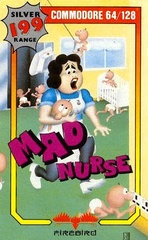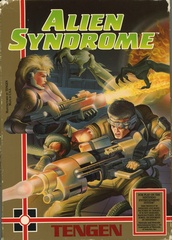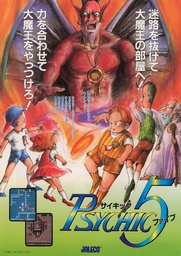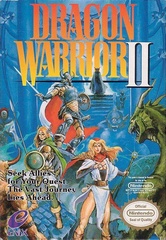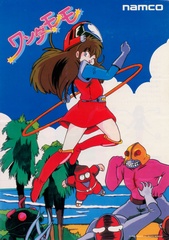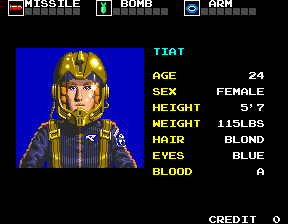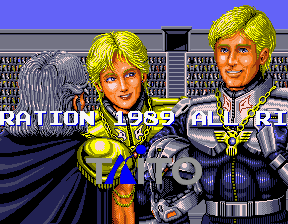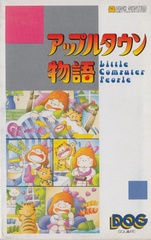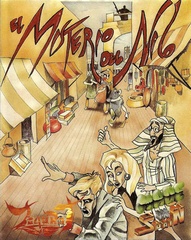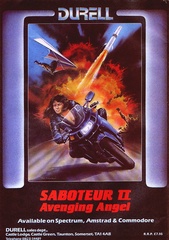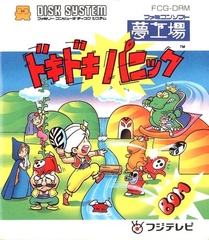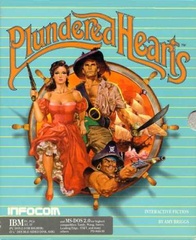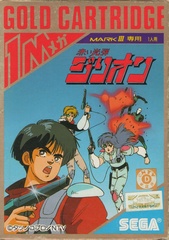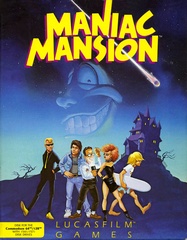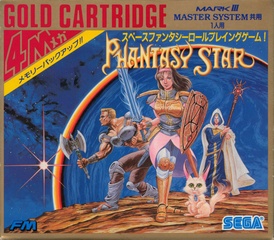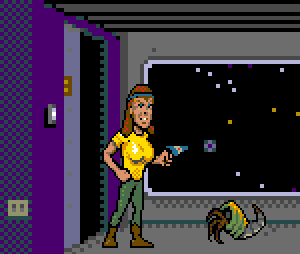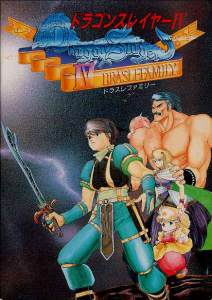Inventories: 1980s Video Game Heroines

Lady Wilde from Legend of the Amazon Women (1986)
Typhoon Gal is not even the only fighting game femme to predate Chun Li. Lady Wilde has the distinction of starring in the first fighting game with an all-female cast, as she stalks through the jungle to beat up a tribe of club-wielding amazons. Like most fighting games that predated Street Fighter II, it's also completely terrible.
The nurses from Mad Nurse (1986)
This game puts you at the command of a whole cohort of Mad Nurses, who serve as additional tries should one of them get fired for neglect. They all have comical names like Brenda Bumwash, Cathy Cuddlecare or Fiona Feedface. Their task is to grab up the toddlers that storm each ward, and carry them into their beds. Disturbing fact no. 1: Never, ever let a baby get too close to a power outlet. The SID screaming will scar you for life. Disturbing fact no. 2: The nurses' main means to prevent this should things get too heated is by gasing the house to temporarily stun all the babies.
Mary from Alien Syndrome (1987)
This Sega arcade game was, clearly, inspired by the Alien franchise. The male hero, Ricky, looks vaguely like Michael Biehn, and the female character, Mary, looks like Sigourney Weaver, at least in the arcade game. In the finale, the two share a romantic kiss, creating an ersatz happy ending that never happened in the movies.
Akiko / Mako from Psychic 5 and Esper Bōkentai (1987)
Psychic 5, a game about four kids with crazy jumping abilities and their old master, is another example of a hero team with exactly one female member. Akiko's (renamed Mako in Esper Bōkentai) strength is hovering over obstacles, similar to Princess Peach in Super Mario Bros. 2, except here it is stat based and not an unique ability. The way the Japanese artist had to make sure that the ten-year-old's underpants show on the advertisement is pretty weird.
Princess of Moonbroke from Dragon Quest II / Dragon Warrior II (1987)
The story of Dragon Quest II begins with the sacking of the Kingdom of Moonbrooke. The hero sets off to save them, and during his journey, he comes across the displaced princess of the country, who joins the adventure after being dispelled of a curse. She serves as the primary spellcaster for the remainder of the game.
Momo from Wonder Momo (1987)
The developers of this arcade game at least gave some personality to Wonder Momo, who mimics the MGM lion roar when the game boots up. She reveals quite a bit of leg when she kicks, pretty much inventing the saying "she kicks high" well before any of the Dead or Alive girls. The game makes her the heroine in an homage/parody to cheapo tokusatsu series (which in the West are most well known by Power Rangers), where she gets to fight villains with silly costumes, like bugmen and creepy masked men in black leotards. Momo of course can transformed into an uniformed justice fighter, who fights with a yellow hoola hoop.
Tiat Young from Darius (1987) and Darius II (1989)
The pilot of the red player 2 ship in Taito's fishy triple-screen shooter is actually a woman, but you'd have to wait through up to three loops of the title demo to have that fact revealed to you in the first game. The sequel shows and mentions both her and her male companion Proco Jr in several of the endings. Especially interesting is the one that suggests that the two might be a married couple. Granted, that is also the joke ending that reveals the entire mission as a dream, so you knever know.
The girl from Apple Town Monogatari: Little Computer People (1987)
While there are several instances of Japanese games that were rid of female protagonists in the US, the Japanese occasionally went the other way. Little Computer People followed the everyday live of a guy when it was conceived by David Crane and Rich Gold in 1985, but when Square ported the game to the Famicom Disk System, they replaced him with a girl. It's debatable whether she can be considered "playable", though. Like the original, Apple Town Story scratches the borders of the definition of "video games" and is more akin to a kind of digital aquarium with little interaction.
Christine AKA Janet Dwight from El Misterio del Nilo / The Mystery of the Nile (1987)
Christine (renamed to Janet Dwight in the English version - the game is originally from Spain) shares the spotlight with two male companions in this Indiana Jones style action adventure. But in a reversal of the damsel-in-distress trope, she is the only available character in the beginning. To make the other two available, she first has to rescue them, bombing and shooting an army of turban-wearing villains on the way.
Nina from Saboteur II: Avenging Angle (1987)
Well, those outside of the UK might not have heard about it, but Saboteur! was quite a popular game in Britain's Spectrum scene. The first game still starred a male ninja, but he was killed off before the sequel, causing his sister to go on a crusade for revenge. The cover still depicted her very unninjalike with waving hair and a plunging neckline, but in the actual game she's fully covered in ninja wardrobe. If you take the game's title screen over the cover, she also might be the first black video game heroine - unless that simply stems from the system's limited color palette.
Mama and Lina from Yume Kojou: Doki Doki Panic (1987)
Nintendo's vaguely Arabian Nights-inspired platformer featured not one, but two female characters in its main cast. They're physically weaker than their male companions, but one of them can jump really high, while the other has the power to float in mid-air for a second or two. The game of course famously became Super Mario Bros. 2, and so one of them just had to be turned into Luigi, while the other was replaced by Princess Peach, who thus became a playable character for the first time. Even though the count of female characters thus went down to one, this was still unusually progressive for the Super Mario franchise - the monarch's next appearance of this kind would only follow five years later in Super Mario Kart. She didn't become playable again in a mainline Mario platformer until 2013's Super Mario 3D World - New Super Mario Bros. would rather have two differently colored clones of Toad - and her first headlining role in 2006's Super Princess Peach had... issues.
Plundered Hearts (1987)
By this point there have been many games starring women, but games actually made by women were still a rarity. Along comes Amy Briggs' interactive pirate romance novel to break that spell. It's still a story mostly driven by the actions of men - the player is more or less assisting her love interest in his fight against the villain, but such are the limitations of a traditional pulp romance story. Yet that also means that the unnamed protagonist is actually allowed to be romantically involved with a dude - something that can apparently still get a game in trouble, as the development history of Remember Me showed.
Apple from Zillion (1987)
This is technically an anime tie-in, but since this was one of the first console games featuring a playable female character released in North America, we'll make the exception. Released as a tie-in with the anime of the same name, this Sega Master System game stars a trio of warriors who wield guns powered by special crystals that allow them to defeat the evil invading Norsa empire. At the outset of the game, only one of these characters, JJ, is playable, and the others, Apple and Champ, must be rescued, after which they become playable as well. Apple is faster than the other characters, though physical weaker, falling into that usual video game stereotype. The English manual was unable to determine her gender, and instead to referred to her as "he". It's not a "closet woman" case, as there's an illustration right next to her, so it was probably a mistake.
Wendy and Razor from Maniac Mansion (1987)
Regardless of its damsel-in-distress story hook, Ron Gilbert's first graphic adventure featured two women among its six selectable supporting protagonists. Razor the punk is the more popular, featured on the cover and also might seem as the more interesting of the two at first glance, but with her sexy outfit that isn't really appropriate for the situation, she's actually more typical of female characters in video games. It's also a shame that every single fan remake (of which there are three, although two are still in development) adhers to the conformist hairdo the former rebel was subdued to in the censored NES version. Wendy as a talented writer is actually much more peculiar in hindsight. Most importantly, both are neither defined by their gender nor simply the same as their male counterparts with a different paint job, but like all characters in the game have their own personality and support the cause with their individual talents (once again Wendy's writing skill is more unique than Razor's musical background, which can also be provided by their male companion Syd).
Leaza from Hayato (1987) and Cosmo Saint Leaza (1987)
Leaza is first introduced as the kidnapped girlfriend of the time traveling male protagonist in Hayato, who joins him after being rescued and fights alongside. Only a few months later, however, she got to star in her very own RPG, where she assembles a group of four adventurers to find a new planet for mankind, which is threatened by the cosmic destruction of its home world.
Alis from Phantasy Star (1987)
The Algol star system is ruled by the evil King Lassic, and the few who stand up against him are ruthlessly murdered. A young man named Nero is gunned down for his role in the rebellion, and only his sister Alis can avenge his death. Alis might not be the first playable female character in an RPG, but she is the first that lies front and center to the game's story. Her outfit is also surprisingly modest for an RPG heroine, eschewing the standard fantasy armor, plus she's both a talented swordfighter and a magician. She appears in the non-canon spinoff Phantasy Star Gaiden, but since the sequels all take place in different time periods, she appears later on only as a dream (in Phantasy Star II) and as a memorial statue (in Phantasy Star IV). The sequel, Phantasy Star II, focuses on Rolf, a male character, but half of its roster includes woman, including Nei, an artificial human; Amy, a doctor; Anna, a hunter; and Shir, a thief.
Dr. Udderbay from Xenophobe (1987)
There are nine different playable characters in Midway's Xenophobe, three for each of the three players. Amidst some really odd characters like Dr. Kwack the duck, there's Dr. Udderbay. Most of the characters have different heads but identical bodies - Dr. Udderbay really only looks like a woman due to her figure. Also, maybe naming her character after a slang term for breasts maybe wasn't the best idea. Even though she is missing from most of the console ports, many of those still show a female space soldier on the cover or ingame art.
Meyna and Lyll from Legacy of the Wizard / Dragon Slayer IV (1987)
Five members of the Drasle Family are charged with exploring the labyrinth that lies beneath their house in order to find the Dragon Slayer sword, in this action-RPG from Falcom. While Roas, the son, is arguably the main character since he's the only one who can use the sword and finish the game, the mother, Meyna and the daughter, Lyll, also play important duties in the quest; Meyna can use certain magical artifacts, while Lyll is the only one who can use the pickaxe.
Heroine from Titantic Mystery: Ao no Senritsu (1987)
Based on an obscure Commodore 64 title, this Famicom Disk System conversion adds a player avatar in the form of a swimsuit-clad woman. There are three "characters" to choose from - Momoko, Mareen and Reika - but all three use the same sprite in-game. Also noteable (??) for being the first video game character to have a shower scene, as illustrated in the manga in the manual.
Blon-Win from The 4th Unit series (1987-1990)
While The 4th Unit goes completely unknown in the West, in Japan it was actually one of the most massive adventure game series during the late 1980s and early '90s, spanning no less than seven titles on various home computer platforms. The heroine with the unusual name is first introduced as an amnesiac, but she was hired as an agent for the Joint Forces to solve all kinds of mysterious crimes. The games are set in a not too distant future, along with the typical cyberpunk elements like evil corporations that control the world, artificial humans and the like. Remarkably for Japanese computer games, the series never seems to go overboard with sexual content, at least from what we've seen. The third game introduces a command for the player to input Blon-Win's emotions.


